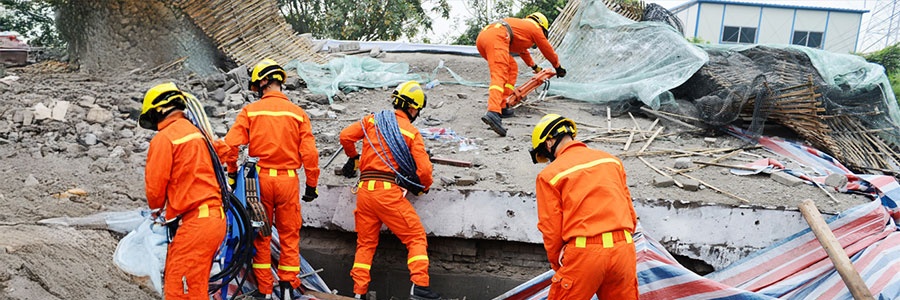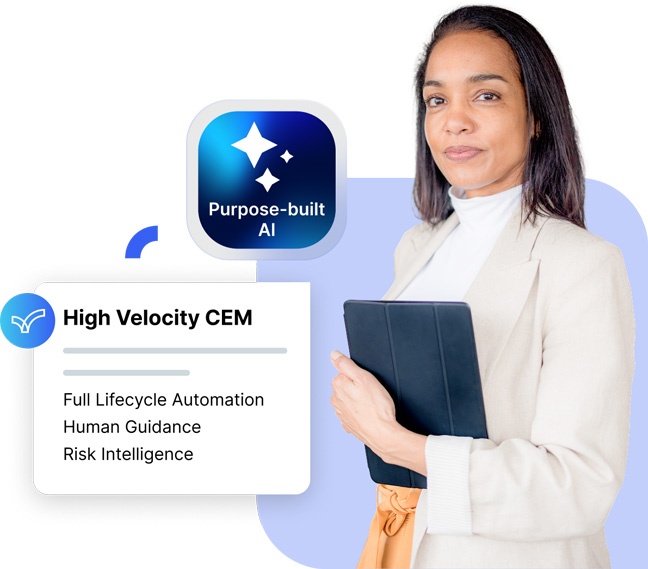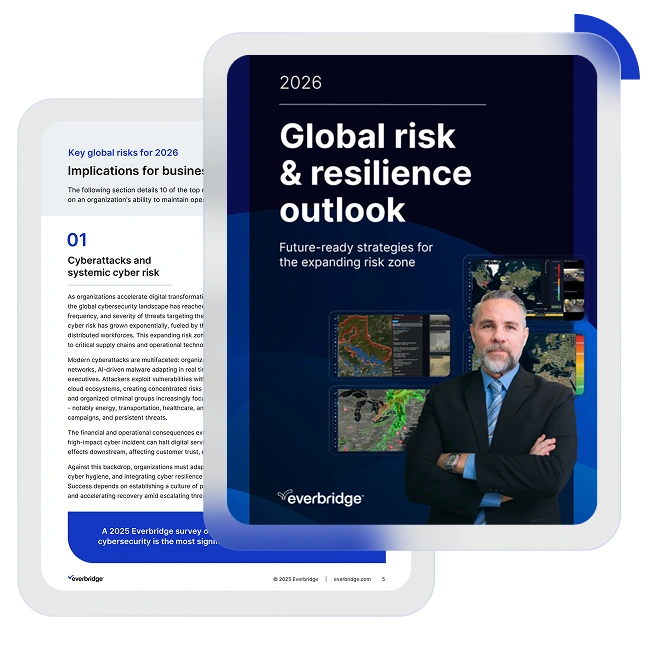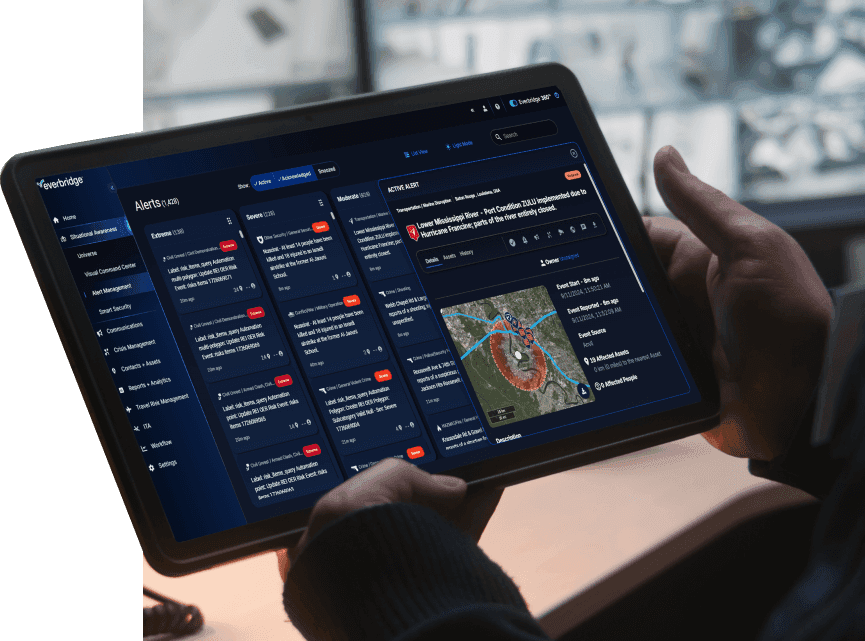A guide to future-ready resilience
The risk landscape is becoming increasingly complex and interconnected. Threats now span industries and regions, requiring businesses to move beyond traditional continuity planning. This blog explores the concept of an “expanding risk zone” and examines the top global risks facing organizations in the year ahead.
The expanding risk zone
Organizations today operate within an “expanding risk zone,” a term that describes the increased exposure to more frequent and intense critical events. This environment challenges outdated business continuity models. Threats no longer happen in isolation; they are often simultaneous and interconnected, creating systemic risk clusters that impact social, operational, and financial domains.
This interconnectedness creates new vulnerabilities. A single event can trigger a cascade of disruptions across your operations and supply chain. As a result, resilience is no longer just a compliance task. It is a strategic imperative for sustained operations and a real competitive advantage. According to a survey conducted here at Everbridge in October 2025, only 31% of global leaders feel extremely confident in their organization’s ability to manage critical events, highlighting a significant readiness gap.
Top 10 global risks for 2026
The Everbridge “2026 Global Risk & Resilience Outlook” identifies 10 critical global risks that organizations must prepare for. Understanding these risks is the first step toward building a future-ready enterprise.
1. Cyberattacks and systemic cyber risk
As businesses adopt more connected technologies, the cybersecurity landscape has become a major concern. Attackers now use sophisticated methods like AI-driven malware and deepfake-enabled social engineering. They target not just core systems but also critical supply chains and operational technology (OT), creating risks that can paralyze entire industries. The impact goes beyond data loss, leading to months of downtime and severe reputational damage.
2. The dual edge of AI
Artificial intelligence offers powerful tools for anticipating and managing critical events. It can enhance decision-making and automate responses. However, AI also amplifies risk. Malicious actors use it to scale attacks and create convincing phishing schemes. The rapid adoption of generative AI, often without strong governance, exposes companies to data leaks, compliance breaches, and biased outcomes.
3. Natural disasters and climate-driven extremes
Extreme weather events like hurricanes, wildfires, and floods are becoming more frequent and intense. These disasters cause direct disruptions to facilities and also have cascading effects on supply networks and regional economies. With rebuilding timelines getting longer and insurance coverage becoming more selective, the chronic risk of interruption is a major challenge to operational resilience.
4. Geopolitical conflict
Geopolitical instability, including tariffs, export restrictions, and sanctions, creates significant volatility. These events disrupt trade flows, create chokepoints in shipping lanes, and cause sudden swings in commodity and energy markets. Organizations that rely on single-region sourcing or just-in-time inventory models are especially vulnerable to these geopolitical shocks.
5. Business interruption from supply chain shocks
Supply chains are more complex and interconnected than ever, meaning a single disruption can quickly halt production and create costly delays. These shocks can come from port congestion, labor shortages, or even digital vulnerabilities. A disruption at a single third-party IT provider, for example, can trigger a “digital domino effect,” spreading operational chaos across multiple enterprises.
6. Misinformation and disinformation
False narratives and deepfake content are rapidly accelerating threats. Targeted campaigns can erode trust, disrupt crisis communications, and manipulate markets. The World Economic Forum has identified misinformation and disinformation as one of the most severe global risks over the next two years. Attacks can damage brands, cause financial loss, and slow an organization’s ability to respond to a crisis.
7. Regulatory fragmentation and trade restrictions
A fragmented patchwork of regulations on issues like data privacy, cybersecurity, and supply chain due diligence creates uncertainty. Sanctions and export controls can change with little notice, forcing companies to adapt continually. This volatility can disrupt cross-border operations, delay shipments, and increase compliance costs, undermining organizational resilience.
8. Macroeconomic and financial instability
Persistent inflation, fluctuating interest rates, and shifting trade policies directly affect working capital, credit access, and revenue streams. These factors can create cash flow pressure, increase costs, and lead to supplier defaults. Even financially sound organizations can face sudden shocks to both supply and demand, testing their financial resilience.
9. Talent shortages and skills mismatch
Demographic shifts and rapid technological change are creating critical skills gaps. When key roles remain unfilled, incident response times lengthen, and institutional knowledge is lost. This erodes business continuity, with longer recovery times and stalled modernization efforts. Treating talent availability as a critical operational risk is now essential.
10. Polycrises
A polycrisis occurs when multiple, independent risks materialize at the same time, amplifying each other’s consequences. For example, a conflict may disrupt supply chains while a cyberattack targets your distributed workforce. This convergence strains operational capacity and overwhelms traditional crisis management protocols, making a coordinated, centralized response critical.
Building a future-ready organization with a five-stage strategy
To navigate the expanding risk zone, leaders need an integrated, proactive approach. Everbridge recommends a five-stage resilience strategy that helps organizations know earlier, respond faster, and improve continuously.
Stage 1: Plan
Move beyond static risk assessments. Use dynamic risk intelligence and scenario planning to anticipate threats and quantify their potential impact. By operationalizing foresight, you can prioritize resources and strengthen business continuity before an event occurs.
Stage 2: Monitor
Maintain 24/7 situational awareness across your people, sites, supply chain, and technology. AI-powered risk intelligence provides the contextual data needed to see disruptions sooner. This allows you to understand who and what is at risk, enabling faster, more informed decisions to protect your operations.
Stage 3: Alert
During a critical event, every minute counts. A high-velocity approach accelerates detection, assessment, and outreach. Use targeted, multi-modal notifications to communicate with clarity and speed. This ensures you can fulfill your duty of care and protect employees, whether they are in the office or traveling.
Stage 4: Respond
Replace fragmented point solutions with a common operating picture. This centralizes decision-making and mobilizes the right people and actions across security, IT, and operations. An orchestrated incident command ensures an efficient and effective response.
Stage 5: Improve
Turn every event into a learning opportunity. Institutionalize continuous improvement with post-incident analysis and performance insights. This full-lifecycle approach helps your teams refine business continuity plans, update playbooks, and strengthen organizational resilience over time.
Securing your organization’s future
The risks facing organizations in 2026 are more complex and interconnected than ever before. The insights from the Everbridge “2026 Global Risk & Resilience Outlook” make it clear that a new approach is needed. Resilience is no longer a static plan, but an ongoing capability that integrates risk management, talent investment, and continuous learning.
Organizations today face an unprecedented array of threats. From cyber-attacks and outages, natural disasters, supply chain disruptions, pandemics, geopolitical events, and sudden regulatory changes, today’s risk environment demands sophisticated preparedness strategies.
The growing prevalence of these threats in recent years has elevated business continuity and resilience to a top priority for organizations. These terms are frequently used interchangeably, which creates confusion and can lead to dangerous gaps in risk management.
Fortunately, this misconception is declining as revealed by the BCI Continuity & Resilience Report 2025, where only 40.2% now claim there is no difference between BC and resilience in their organizations.
Understanding the distinction is essential for building a comprehensive strategy that ensures your organization can both survive immediate threats and thrive through long-term uncertainty.
Whether you are developing your first continuity plan or evolving a mature program, understanding these differences will strengthen your organization’s ability to withstand disruption and emerge stronger.
What is business continuity?
Business continuity is an organization’s capability to maintain critical operations at acceptable levels during and after disruptions. When incidents happen, established procedures and processes are used by organizations to guide response and recovery.
The foundation of business continuity rests on three core components:
- Backup systems that ensure alternative resources are available when primary systems fail. These might include redundant data centers, alternative communication channels, or standby equipment that can be activated quickly.
- Recovery procedures that provide step-by-step instructions for restoring operations after disruption. These documented processes detail exactly what actions to take, who should take them, and in what sequence to minimize downtime.
- Emergency response protocols guide immediate actions during crisis situations. These protocols prioritize safety, establish command structures, and coordinate initial response activities across the organization.
Business continuity planning emphasizes maintaining minimum acceptable service levels. Rather than optimizing performance during disruption, the goal is to ensure critical functions continue at predetermined thresholds until normal operations can resume.
What is business resilience?
Business resilience represents your organization’s ability to overcome, adapt, and evolve in response to unexpected disruptions. Unlike the reactive nature of business continuity, resilience takes a forward-looking, strategic approach that builds organizational flexibility before incidents occur.
This capability extends beyond recovery to encompass adaptation. Resilient organizations do not simply return to previous operating states; they see disruptions as opportunities to improve processes, strengthen systems, and enhance performance. This distinguishes resilience from traditional continuity planning.
Business resilience integrates into daily operations rather than activating only during crises. The capabilities that enable resilience (flexible systems, adaptive culture, diversified resources) function continuously, allowing organizations to respond dynamically to emerging challenges without requiring formal plan activation.
Business resilience demands investing in agility. This means building workforce skills for quick deployment, diversifying supplier options, and adopting flexible technology. These steps provide essential capacity during disruptions.
Business continuity vs. Business resilience: Key differences
Business continuity focuses on maintaining operations during and after disruptions, while business resilience encompasses the broader capability to adapt, evolve, and strengthen organizational capacity over time.
The fundamental distinction between business continuity and resilience lies in their underlying philosophies:
| Business Continuity | Business Resilience |
| Response to incidents | Preparation for uncertainty |
| Focus on recovery and restoration | Focus on adaptation and evolution |
| Event-driven activation | Continuous operational integration |
| Maintaining minimum service levels | Optimizing performance through disruption |
Metrics and measurement
Both approaches utilize shared metrics while maintaining unique measurement priorities:
- Recovery Time Objective (RTO) defines the maximum acceptable downtime for critical systems. This metric is essential for business continuity planning, establishing clear recovery targets. For business resilience, RTO represents one input among many when assessing organizational adaptive capacity.
- Recovery Point Objective (RPO) specifies the maximum acceptable data loss during disruption. Business continuity uses RPO to determine backup frequency requirements. Resilience planning considers RPO when evaluating whether acceptable data loss thresholds align with organizational risk tolerance.
- Mean Time to Recovery (MTTR) measures the average time required to restore operations after incidents. This business continuity metric tracks recovery efficiency over multiple events. Resilience programs analyze MTTR trends to identify whether organizational adaptive capacity is improving.
- Incident Response Time captures how quickly organizations activate response procedures when a disruption occurs. For business continuity, faster response times indicate better preparedness. Resilience programs evaluate whether response speed improves as organizational capabilities mature.
- System Downtime quantifies the total time critical systems remain unavailable. Business continuity aims to minimize downtime through effective recovery procedures. Business resilience seeks to reduce downtime impact through flexible work processes that maintain productivity despite system unavailability.
- Cost of Recovery calculates expenses incurred when restoring operations after a disruption. Business continuity uses this metric to justify investment in backup systems and recovery capabilities. Resilience planning evaluates whether adaptive approaches reduce recovery costs compared to traditional continuity methods.
Assess how resilient your organization is and how prepared you are for business disruptions. Try our free assessment to see how your organization compares to leaders in your industry.
Achieving both business continuity and resilience
Modern organizations require both reactive recovery capabilities and proactive adaptive capacity. The most effective strategies integrate these concepts through a comprehensive platform that unifies continuity and resilience efforts.
The Everbridge High Velocity Critical Event Management (CEM) platform unites these approaches, providing technological infrastructure that supports immediate incident response while building long-term organizational resilience.
By integrating real-time threat intelligence, automated response, and comprehensive communication, organizations can move beyond reactive planning and toward proactive, holistic preparedness.
Ready to elevate your business continuity and resilience capabilities? Take a personalized tour of Everbridge BCIC to discover how to transform your organization’s approach to risk management and preparedness.

Top 10 questions to ask when Choosing the right business continuity platform
In today’s environment of heightened risk, operational complexity, and regulatory scrutiny, selecting the right business continuity platform is more than a technical decision—it’s a strategic imperative. Whether you’re a Business Continuity Manager ensuring plan effectiveness, a Risk Officer safeguarding compliance, or an IT Disaster Recovery (DR) leader striving for uninterrupted service delivery, your organization’s resilience depends on having the right tools in place.
Everbridge delivers a business resilience advantage with High Velocity CEM™, protecting organizations from the impact of critical events. By combining market-leading innovation, decision-ready risk intelligence, and full lifecycle automation, Everbridge ensures that managing critical events is as easy as 1-2-3. Only Everbridge helps organizations know earlier, respond faster, and improve continuously.
Selecting the right business continuity platform is a significant decision with long-term implications. It’s therefore essential to ask the right questions to ensure that the chosen solution aligns with your organization’s unique needs. To simplify your due diligence process, we’ve compiled the top 10 questions to ask potential business continuity vendors, along with valuable insights to guide your evaluation.
1. How does the platform centralize data and processes?
A strong platform should consolidate all business continuity, disaster recovery, and risk data into a single system. Centralization ensures consistency by using key data sources, reduces silos, improves visibility, and streamlines decision-making during disruptions.
What to ask:
- What type of templates are provided out of the box to get me started?
- Can the platform integrate data from existing tools like HR, facilities management, IT CMDB, risk management, and incident management solutions?
- Are there standardized import templates to manage my data?
- Does the platform provide an enterprise impact map with a unified view of dependencies and risks in my organization?
- Can I visually see upstream and downstream dependencies to understand single points of failure and critical assets?
- Can the data be segmented between business and IT DR?
- Does the platform provide standard summary reports and dashboards to see the health and status of my program and gaps to be addressed?
2. How configurable and adaptable is the platform?
The platform should be flexible enough to meet your organization’s unique needs while allowing for future growth and changes.
What to ask:
- Can I add new data tables and fields to match my organizational data?
- Are templates, calculations, and reports modifiable?
- How easily can I create new assessment templates, plan templates, and reports?
- Can I enhance a template and retain historical information and responses?
- Do I need technical expertise to apply changes to my templates, calculations, and reports? Does this require engagement with the vendor or a third party?
- Will I still receive upgrades and enhancements if I made configuration changes or modified templates?
3. Does the platform support regulatory compliance?
Compliance is a critical component of business continuity and disaster recovery. The platform should help you meet standards like ISO 22301, FFIEC, FCA, DORA, and SOC 2 while simplifying audit preparation.
What to ask:
- Does the platform provide audit logging of Business Continuity (BC)/DR activities?
- Will I receive updated templates and reports that align with regulatory requirements?
- Is there an automated workflow to alert users when information requires attention or updating?
- Can I easily generate compliance reports to provide to auditors and examiners?

4. What pre-built resources and templates does the platform offer?
Look for platforms that provide ready-to-use templates and workflows aligned with industry standards to save time and ensure consistency.
What to ask:
- Are the templates aligned with industry standards and best practices?
- Do they cover key areas like impact assessments, planning, testing, risk management, and reporting?
- Can templates be easily configured without technical expertise?
- Can I easily modify dropdown options to align with my terminology and resource types?
5. Dependencies
Understanding dependencies is key to effective recovery planning. The platform should visualize upstream and downstream dependencies and identify single points of failure.
What to ask:
- Can I configure the dependency view to see what matters to me?
- Are orphaned records and critical dependencies easily viewable?
- Does the platform provide tools to assess the impact of failures across the organization?
- Can I filter and see key asset dependencies at multiple levels?
- Are dependencies considered when testing my plans?
- Can I see where there are gaps in my response and recovery times for key dependencies such as applications and suppliers?
6. What type of reporting is available in the platform?
All tasks are not the same and should be dynamic based on the response phases and plan type they are associated with.
What to ask:
- Does the platform provide out-of-the-box reports for Business Impact Analysis, Plans, Risks, and Testing?
- Can I create new reports?
- Can reports be automatically sent to stakeholders without manual intervention?
- Are gaps for recovery time objectives (RTOs) easily identified (i.e. application recovery, supply chain, exercises)?
- Are summary reports available to roll data up to location, business entity, or executive leader/stakeholder?
- Can non-licensed users access copies of plans?
- Does the platform provide standard summary reports and dashboards to see the health and status of my program and gaps to be addressed?
7. What automation capabilities does the platform offer?
Automation reduces manual effort and ensures consistency. The platform should support automated workflows for creating, updating, and approving plans, as well as testing and tracking results.
What to ask:
- Can the platform automate alerts, testing, and reporting?
- Does it include automated workflows for cross-departmental collaboration?
- Can workflows be modified based on my organizational settings and frequency for updates?
- Can the platform escalate delinquent activities to leadership for higher levels of visibility and accountability?

8. How does the platform support program visibility?
Dashboards and analytics are essential for tracking program health and readiness. The platform should provide real-time insights and executive-level reporting.
What to ask:
- Can it generate reports that communicate ROI and resilience metrics to stakeholders?
- Does it offer dashboards to visualize program health and readiness?
- Can I create or modify my own reports or do I need to engage with the vendor?
- Can I track the progress of recovery when conducting an exercise/test?
9. Does the planning platform provide integration with critical event management?
Integrating planning with critical event management is essential because it bridges the gap between proactive preparedness and real-time response. Together, they create a seamless, end-to-end approach for managing disruptions, ensuring the plan information is accessible, visible, and leveraged for response activities.
What to ask:
- Does the platform provide automated integration between planning and critical event management for free?
- What information is available from my BIA (Business Impact Analysis) and plan to help make informed decisions regarding impact?
- Can I see the dependencies and resources required for recovery?
- Can I activate plan response strategies and track recovery tasks being completed?
- Does my executive team understand why incidents were invoked and see incident trends over time?
- Does the platform show my team which services to restore and in what order during an incident?
10. What training and support are available?
Even the most intuitive platform requires training and support. The vendor should offer resources to ensure smooth onboarding and long-term success.
What to ask:
- What onboarding and training options are included?
- Is ongoing support available to address future needs and challenges?
- Is support a paid service or included in the subscription?
- Do I need to engage with a third-party vendor for support or changes to myprogram and what is the cost?
- Are there self-service training sessions available if I want to expand my use of theplatform?
- Do I need a license for test participants and infrequent users such as plan or BIAapprovers?
- How long is a typical implementation?
Making a well-informed decision
Choosing the right business continuity platform isn’t just about features; it’s about finding a reliable partner. By asking these 10 questions, you’ll be equipped to identify the best solution for your organization’s needs, ensuring resilience and operational continuity for years to come.


